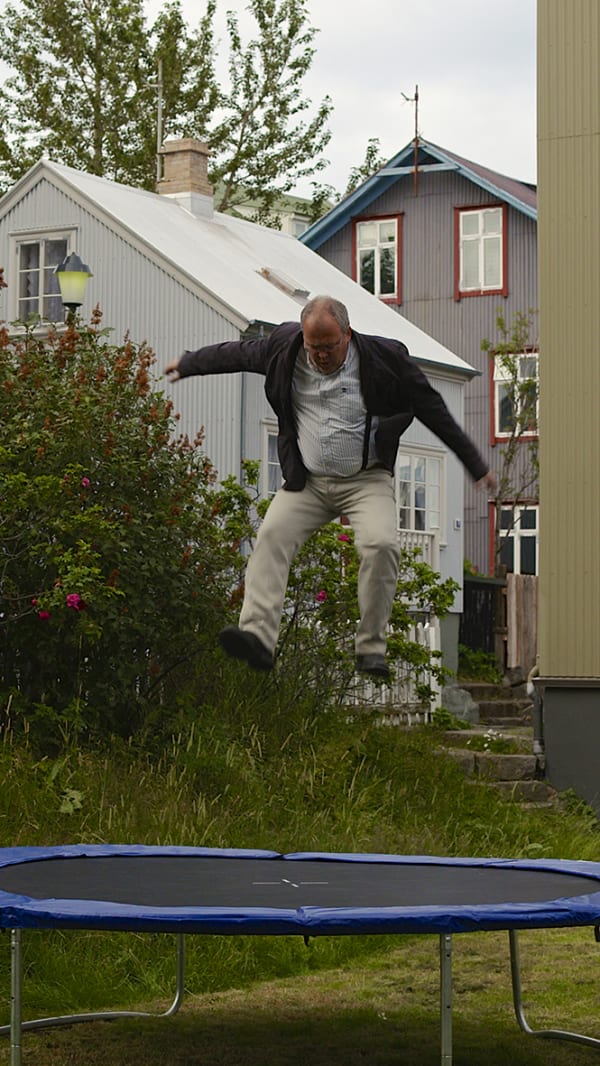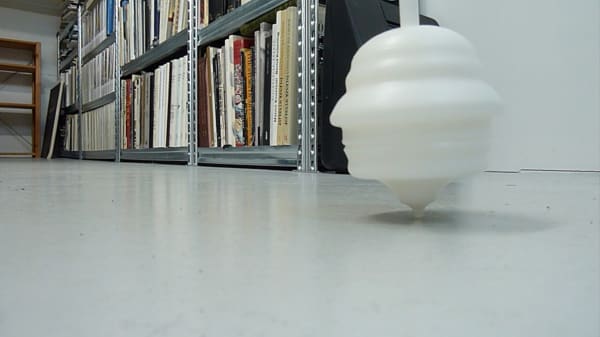HREINN FRIÐFINNSSON: A Portrait of a Sculptor as a Sculpture, with a Sculpture by the Sculptor
The exhibition centres on Fridfinnsson’s A Portrait of a Sculptor as a Sculpture, 2014 – a group of five videos. Each part portrays the sculptor Kristinn E. Hrafnsson, who is Fridfinnsson’s friend of many years, performing simple, everyday actions in various public and private places throughout the city of Reykjavik. In this series of vignettes, displayed on screens around the gallery, the Sculptor is seen bouncing on a trampoline, swinging on a playground swing, ice-skating, crocheting, and hula hooping.
Featuring alongside this work is Hrafnsson’s sculpture, Spinning Top, 2014, a trophy-like piece in brass. Also on display is a short video, Set to Spin, showing a model of the object in action; as the spinning top reaches a certain speed, its profile reveals an eerie sculptural likeness of Fridfinnsson. This unique portrait pays homage to the older artist, but does so with a wink and a nod, for the younger artist’s spin top embodies many of the older artists explorations.
In Fridfinsson’s five videos, the sculptor’s statuesque quality transforms him into a sculpture, as if through Ovidian metamorphoses, he – the sculptor as sculpture – performs various circular movements, his body drawing, forming, and creating circles through different processes. It exposes the invisible force of gravity as he bounces on a trampoline or acts as a pendulum’s plumb on a swing. Both weight and mass are at work here, taking into account the force of inertia, or action and re-action. The work´s individual titles refer to physical laws of forces of acceleration and motion such as angular momentum.
Circular patterns – be they in the crocheting of a hat, the path of the ice skater, the rhythmical motion of the hula-hooper and his hoop, or the reading of the weather forecast from stations around the coast of Iceland – are put in context with larger ellipses and phenomena. These patterns, however, share in the greater phenomena laws like the angular momentum, or kinetic energy, also made evident in the ebb and flow of the sea and the setting sun as proof of Earth’s rotation. Hence, one and the same law goes for all things whether we consider spinning tops on Earth or planets and comets in space.
Fridfinnsson has conceived this new work not only as the portrait of a sculptor as the symbol of sculpture, but also as an instructional piece outlining all the precepts of the medium. Sculpture may be the very image of stability – something monumental, solid and still – yet it relies on circular movements and gravitational pull and balance. In rendering visible a body moving in so many different ways in relation to the Earth’s own forces, Fridfinnsson alludes to the powers we are governed by, in his usual poetic way, and by doing so considers time, metaphysics as well as the duality of all things.









